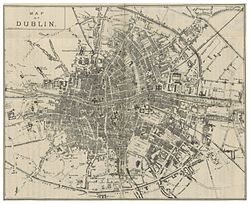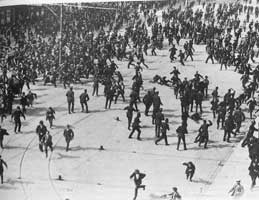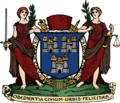Dublin Metropolitan Police
 From Wikipedia - Reading time: 11 min
From Wikipedia - Reading time: 11 min
| Dublin Metropolitan Police Póilíní Chathair Átha Cliath | |
|---|---|
 | |
| Common name | Peelers, bobbies |
| Abbreviation | DMP |
| Agency overview | |
| Formed | 1836 |
| Preceding agency |
|
| Dissolved | 1925 |
| Superseding agency | Garda Síochána |
| Legal personality | Police force |
| Jurisdictional structure | |
| National agency | United Kingdom of Great Britain and Ireland |
| Operations jurisdiction | Dublin, United Kingdom of Great Britain and Ireland |
 | |
| Map of Dublin city, 1891 | |
| Size | 114.99 km2 (44.40 sq mi) |
| Population | 233,726 (1841) 304,802 (1911) |
| General nature | |
The Dublin Metropolitan Police (DMP) was the police force of Dublin in British-controlled Ireland from 1836 to 1922 and then the Irish Free State until 1925, when it was absorbed into the new state's Garda Síochána.
History
[edit]
19th century
[edit]The Dublin city police had been subject to major reforms in 1786 and 1808.[1] Organised rural policing in Ireland began when Robert Peel, then Chief Secretary for Ireland, created the Peace Preservation Force in 1814.[2] This rudimentary paramilitary police force was designed to provide policing in rural Ireland, replacing the 18th century system of watchmen, baronial constables, revenue officers and British military forces. Peel went on to found the London Metropolitan Police.
In 1822, a new act[which?] created four improved "county" constabularies, whose organisation was based around the traditional provinces of Ireland.[2]
1836: reform
[edit]| Dublin Police Act 1836 | |
|---|---|
| Act of Parliament | |
 | |
| Long title | An Act for improving the Police in the District of Dublin Metropolis. |
| Citation | 6 & 7 Will. 4. c. 29 |
| Dates | |
| Royal assent | 4 July 1836 |
| Other legislation | |
| Amended by | |
| Repealed by | Statute Law (Repeals) Act 2013 |
Status: Repealed | |
In 1836, the county constabularies were merged into a new centralised Constabulary of Ireland, and the Peace Preservation Force ceased to exist.[2] At the same time separate non-paramilitary forces were set up in the largest cities: Dublin, Belfast, and Derry. A perceived lack of impartiality following rioting in the municipal police forces of Belfast and Derry saw both forces absorbed by the national force in 1865 and 1870 respectively, and only Dublin maintained its separate force.[2] The DMP was established under the Dublin Police Act 1836 (6 & 7 Will. 4. c. 29) as an unarmed, uniformed force of one thousand day and night constables. The Castle-controlled organisation was more accountable than the untrained constables and night watchmen it replaced.[1][3]
The 1836 Act authorised the "chief governor of Ireland" to establish a police office in Dublin, supported by two salaried justices, to administer the police force which would be under the direction of the Chief Secretary for Ireland.[3] It also provided for the recruitment and appointment of policemen and the regulation of their conduct.[3] It also created powers of arrest and made arrangements for the financial affairs of the new force, including new taxation.[3]
The DMP was modelled closely on London's Metropolitan Police. Not only were the uniforms of the two forces almost indistinguishable, especially after the helmet and Bath Star were adopted, but the two forces also had a similar organisational structure; rather than a Chief Constable, they were commanded by a Commissioner, who was not a police officer, but a magistrate holding a Commission of the Peace. The first Commissioner of the Dublin Metropolitan Police was John Lewis More O'Ferrall, brother of Richard More O'Ferrall.[4] This was descended from the 18th century system of controlling parish constables, and was a sop to the public's fears about the danger of a standing police force under government control.

1880s: Land War
[edit]The force came under considerable pressure in the 1880s during the Land War, in which 500 policemen were injured. A series of protest meetings were held and strikes were threatened in 1882.[3]
20th century
[edit]
1913–14: Dublin Lock-out
[edit]Two men died and several hundred people were injured over the course of the five-month Dublin Lock-out, including two hundred policemen. Although the police were involved in "frequent collisions" with union members and used tactics such as baton charges against them, a vice-regal commission cleared them of wrongdoing after the events – though their reputation had suffered considerably.[3]
1916 onwards
[edit]As an unarmed urban force, the Dublin Metropolitan Police did not participate as actively in the Easter Rising of 1916 and War of Independence as did the RIC, and as such did not suffer the casualty rate of that force. Three men were killed and seven injured in the Rising.[3] One of their number David Neligan (who was an IRA agent) records in his book The Spy in the Castle that the majority of the DMP uniformed personnel observed a neutral role, restricted to traditional policing functions. The political "G" Division did not come off so lightly, and selected "G men" were first given warnings by the Irish Republican Army in April 1919. Five members of "G" Division were subsequently killed by the IRA, the first in July 1919. Several DMP officers actively assisted the IRA, most notably[5] Edward Broy, who passed valuable intelligence to Michael Collins throughout the conflict.
In the 1996 film Michael Collins, Broy is discovered and subsequently tortured and killed by the British. In reality, he was not caught and went on to become the Commissioner of the Garda Síochána in the 1930s. His fate in the film is based on that of Dick McKee, who, with Peadar Clancy and the civilian Conor Clune, was murdered after torture in Dublin Castle on "Bloody Sunday", 21 November 1920.[6]
After the creation of the Irish Free State, the DMP became known as "Políní Átha Cliath" (Police of Dublin) from 1922 to 1925, after which the force ceased to exist as a separate entity, being absorbed into the Garda Síochána (Guardians of the Peace).[3] Its last Commissioner was W.R.E. Murphy. "Dublin Metropolitan" is today a geographic region of the Garda Síochána's command structure.
Unlike the RIC, but in common with police forces in Great Britain, the DMP was an unarmed force. In contrast to the green uniformed RIC, the DMP wore dark blue with silver insignia.
Ranks
[edit]| Ranks[7] circa 1893–1901 | |||||||||||
|---|---|---|---|---|---|---|---|---|---|---|---|
| Chief Commissioner | Commissioner | Chief superintendent |
Superintendent | Inspector | Sub-Inspector | Station Sergeant |
Staff Sergeant | Sergeant | Constable | Supernumerary Constable | |
| Ranks[8][9][10][11][12] circa 1918–1924 | |||||||||||
| Commissioner | Divisional commissioner |
Assistant divisional commissioner |
Chief superintendent |
Superintendent | Inspector | Station Sergeant |
Staff Sergeant | Sergeant | Constable | Supernumerary Constable | |
References
[edit]- ^ a b Stanley H. Palmer, 'Drummond, Thomas (1797–1840)', Oxford Dictionary of National Biography, Oxford University Press, 2004; online edn, Jan 2008
- ^ a b c d Tobias, J.J. (1975). "Police and the Public in the United Kingdom" in "Police Forces in History". Sage Publications. ISBN 978-0-8039-9928-2.
- ^ a b c d e f g h "Statute Law Repeals: Consultation Paper – City of Dublin Repeal Proposals" (PDF). Law Commission. Archived (PDF) from the original on 2 June 2011. Retrieved 22 April 2011.
- ^ Murphy, David. "O'Ferrall, John Lewis More". Dictionary of Irish Biography. Archived from the original on 11 May 2021. Retrieved 11 May 2021.
- ^ Forester, Margery (2006). Michael Collins: The Lost Leader. Dublin and London: Gill & MacMillan, Limited. pp. Chapter 7 onward. ISBN 978-0717140145.
- ^ Forester, Margery (2006). Michael Collins: The Lost Leader. Dublin and London: Gill & MacMillan, Limited. pp. Chapter 11. ISBN 978-0717140145.
- ^ "Dublin Metropolitan Police 1836-1922". Archived from the original on 4 February 2021. Retrieved 23 January 2021.
- ^ "53". Constabulary and Police (Ireland) Act, 1918 (PDF). Archived (PDF) from the original on 12 November 2020. Retrieved 23 January 2021.
- ^ "Dublin Metropolitan Police general register 1837-07 – 1925-01". Archived from the original on 30 January 2021. Retrieved 23 January 2021.
- ^ "R.I.C and D.M.P. Uniform, Badges and Buttons". Archived from the original on 26 January 2021. Retrieved 23 January 2021.
- ^ "Police Forces Amalgamation Act, 1925". Archived from the original on 29 January 2021. Retrieved 23 January 2021.
- ^ "War of Independence R.I.C. and D.M.P. Killed". Archived from the original on 29 January 2021. Retrieved 23 January 2021.
External links
[edit]- DMP Roll of Honour in the British National Police Officers Roll of Honour (since this only covers UK forces, the DMP pages only cover up to 1922)
- Article about DMP on occasion of centenary of 1913 Lockout
- A History of the Dublin Metropolitan Police and Its Colonial Legacy
- Dublin Metropolitan Police (DMP) Prisoners Books 1905-1918. A UCD Digital Library Collection.
- DMP Annual Reports 1875 to 1912 Garda Síochána website
 KSF
KSF